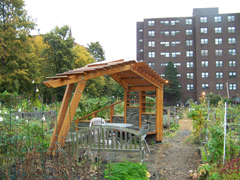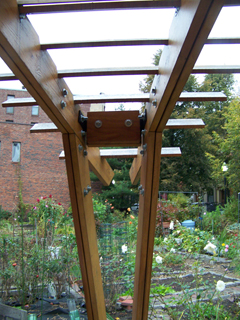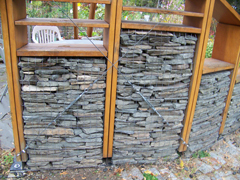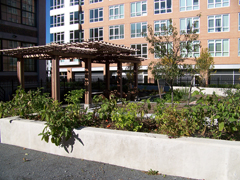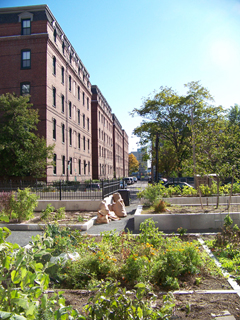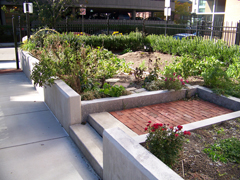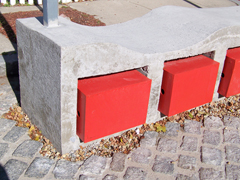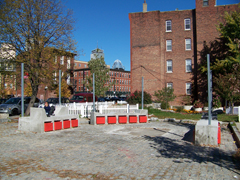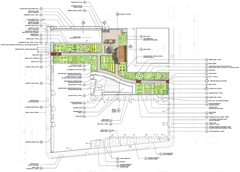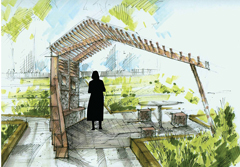South End Lower Roxbury Community Gardens
Exhibit Category / Catégorie de l'expo: Community & Knowledge
Location/Emplacement: Boston, MA, USA
Dates: 2008 - present
Designers/Concepteurs: Worcester and Douglass Gardens: Urban Design BUILD Program, Boston Architectural College — Harrison Garden: James A Heroux, Strata Design Associates Inc., ADD Inc.
Clients: South End Lower Roxbury Open Space Land Trust
More Information/Plus d'informations: The Trustees - South End/Lower Roxbury Open Space Land Trust — http://worcesterstreetgarden.org/
Image Credits/Crédits d'images: Joe Nasr
Project Description: (version française ci-dessous)
The South End Lower Roxbury Open Space Land Trust (SELROSLT) is a membership-supported, non-profit organization that works to acquire, own, improve, and maintain open space for community gardening and pocket parks in the South End of Boston and neighbouring Lower Roxbury. This area has long been among the poorest in Boston, though it has been undergoing strong gentrification and redevelopment pressures in recent years. Today approximately 600 gardeners use the 16 community gardens that SELROSLT holds and operates, growing a wide variety of food, flowers and plants.
SELROSLT has been working with architects on the design of several of their gardens. The first of these collaborative projects was the Worcester Street Garden Pavilion designed by students from the Boston Architectural College. The structure is intended to serve multiple purposes while providing a central gathering space at the heart of the garden. The architecture students surveyed the needs of the gardeners and responded with a structure that provides shade and a place to have a meal or to gather with other gardener friends.
A similar process was followed in the second year of this collaboration, in a separate SELROSLT garden, the Frederick Douglass Peace Park. The very different context of this garden resulted in an entirely different approach. Students designed and fabricated a deployable stage within a public square, creating an amphitheatre positioned between a community-run flower and vegetable garden and an adjacent social housing project. This space is now used for musical performances, barbecues and other social gatherings.
The Harrison Urban Garden (HUG) is the newest community garden in the South End of Boston, completed in 2008, sitting on the site of a former battery factory. It is part of a mixed-use residential/commercial project with a substantial affordable housing component. This urban garden is unique in that it rests over an underground parking garage – an engineered soils medium, approximately 36” deep, was used for garden plots, with drainage mats and water-proofing protect the garage below. Since the community garden was part of a larger mixed-use development, the project had to be designed to create the best solution possible for the growing of food and other plants, and to act as a public space for the new neighbourhood in addition to a collection of plots.
As community gardens are becoming increasingly multifunctional and visible public spaces, their design is becoming increasingly crucial. Sensitivity to a variety of purposes is becoming necessary – going beyond a simple, efficient distribution of production plots. The range of situations encountered by the SELROSLT is thus indicative of an increasingly common trend towards a role for design (and designers) in community gardens.
Browse for more projects in the Carrot City Index.
Description du Projet:
La société foncière de South End Lower Roxbury (SELROSLT) est une organisation à but non lucratif qui cherche à acquérir, améliorer et maintenir des espaces libres pour le jardinage communautaire et des « pocket parks » (mini-parcs) dans la partie sud de Boston et le quartier voisin de Lower Roxbury. Cette zone a longtemps été parmi les plus pauvres de Boston, bien qu’elle ait connu de fortes pressions de gentrification et de redéveloppement ces dernières années. Aujourd’hui, près de 600 cultivateurs utilisent les 16 jardins communautaires dont SELROSLT est propriétaire et assure la gestion pour cultiver une variété de légumes, de fleurs et de plantes.
SELROSLT travaille avec des architectes paysagistes pour la conception de ses jardins. Le premier projet de collaboration était le pavillon du jardin de Worcester Street conçu par les étudiants de l’école d’architecture de Boston. La structure a été planifiée pour assurer plusieurs fonctions tout en offrant un espace central de rencontre au cœur du jardin. Les étudiants ont recueilli les besoins des cultivateurs et ont proposé une structure qui offre à la fois de l’ombre et un endroit pour se restaurer ou se réunir entre cultivateurs-jardiniers.
Un procédé similaire a suivi la deuxième année de collaboration, dans un autre jardin de SELROSLT, le Frederick Douglass Peace Park. On vient y faire des performances musicales, des barbecues, ou d’autres réunions. Ce contexte particulier a nécessité une approche entièrement différente. Les étudiants on conçu et fabriqué une scène dépliable à l’intérieur d’un carré public, créant ainsi un amphithéâtre entre un jardin communautaire de fleurs et de légumes et un immeuble de logements sociaux adjacent. Cet espace est maintenant le foyer de performances musicales, de barbecue en plein-air et d’échanges sociaux.
Le jardin urbain Harrison (HUG) est le dernier jardin communautaire de la partie sud de Boston. Achevé en 2008 sur le site d’une ancienne usine de piles électriques. Il fait partie d’un projet mixte résidentiel-commercial avec un ensemble important de logements à loyer modique. Ce jardin urbain est unique par sa situation : sur un garage à voiture sous-terrain, un sol créé artificiellement de près d’1m de profondeur a été utilisé pour les parcelles de jardins et équipé d’une membrane de drainage et d’un système d’étanchéification pour protéger le garage en dessous. Comme le jardin communautaire fait partie d’un plan de développement mixte, le projet a du être conçu de telle manière à offrir la meilleure option possible pour la culture de légumes et d’autres plantes, et à servir d’espace public pour le nouveau quartier, en plus d’une collection de parcelles.
La multifonctionnalité et la visibilité des jardins communautaires en tant qu’espaces publics augmentant, la phase de conception est donc cruciale. Il devient de plus en plus nécessaire qu’ils puissent assurer plusieurs usages et fonctions, au delà de la simple distribution efficiente de parcelles de production. L’éventail de situations rencontrées par SELROSLT montre qu’il y a un intérêt croissant pour la conception (et les designers) de jardins communautaires.
Trouvez d’autres projets avec l’Index de Carrot City.


